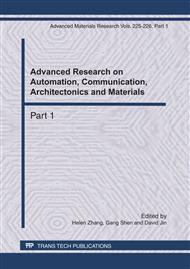p.802
p.807
p.812
p.816
p.823
p.827
p.831
p.835
p.839
Risk Analysis for the Construction Phases of Long-Span CFST Arch Bridge Based on Finite Element Analysis
Abstract:
As a part of virtual simulation of construction processes, this paper deals with the quantitative risk analysis for the construction phases of the CFST arch bridge. The main objectives of the study are to evaluate the risks by considering an ultimate limit state for the fracture of cable wires and to evaluate the risks for a limit state for the erection control during construction stages. Many researches have been evaluated the safety of constructed bridges, the uncertainties of construction phases have been ignored. This paper adopts the 3D finite element program ANSYS to establish the space model of CFST Arch Bridge, and to calculate the linear, the geometrical nonlinear and the double nonlinear buckling safety factors under the six different lode cases. Then the bridge’s risks are evaluated according to the results calculated which provide a reference for design of similar project.
Info:
Periodical:
Pages:
823-826
Citation:
Online since:
April 2011
Authors:
Price:
Сopyright:
© 2011 Trans Tech Publications Ltd. All Rights Reserved
Share:
Citation:


